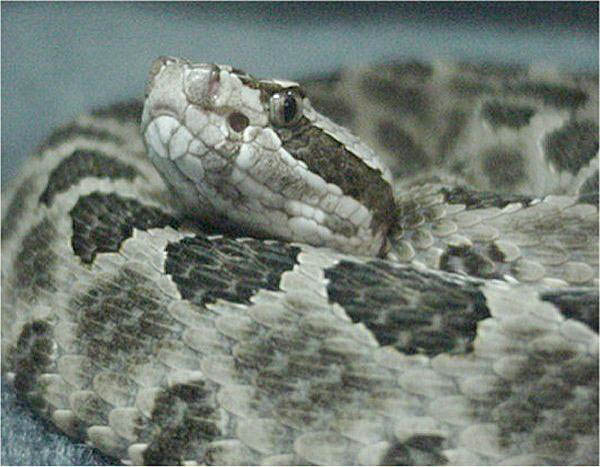Wildlife North America . com North American Animals - mamals, birds, reptiles, insects |
Western Massasauga (Sistrurus catenatus tergeminus)
Western Massasauga Photograph by LA Dawson. Some rights reserved. (view image details)
WESTERN MASSASAUGA FACTS
DescriptionThe Western Massasauga has tan-gray or light gray background color with dark brown blotches. The underside is light with some dark markings. The head has a dark broad stripe along each side. They have a high pitches rattle sound, giving them the nickname buzztail. They are mainly nocturnal, but are sometimes seen basking in the sun during the day. They are most often seen after rain storms. Other Names Ground Rattlesnake, Gulf coast Massasauga, Prairie Rattlesnake, Triple-spotted Rattlesnake Size 35 cm to 91 cm. (average 45cm - 70cm) Environment grassland areas, edges of open woodland, rocky hillsides. They often shelter in animal burrows. Food eat mainly rodents, may also eat lizards and frogs. Breeding The Western Massasauga gives birth to live young (ovoviviparous). Range Found in the United States in south eastern Nebraska, north western Missouri, east and central Kansas, west and central Oklahoma, northern and central Texas Notes Massasauga venom is one of the most potent of all rattlesnake venoms. However it is has limited capability to deliver a large amount of venom in a single bite. They are not considered to be deadly, but the venom can cause swelling, necrosis, and severe pain. Seek immediate medical treatment if bitten. Classification
Relatives in same Genus Desert Massasauga, Buzztail (S. catenatus edwardsii) Dusky Pigmy Rattlesnake (S. miliarius barbouri) Carolina Pigmy Rattlesnake (S. miliarius miliarius) Western Pigmy Rattlesnake (S. miliarius streckeri) Home | Mammals | Reptiles | Birds | Insects | Privacy Policy | Disclaimer | Contact Us |